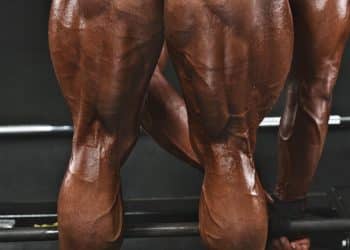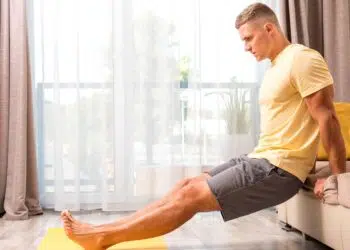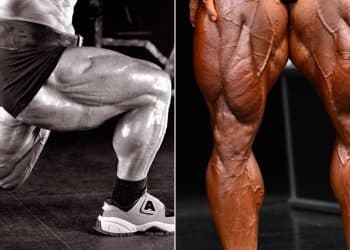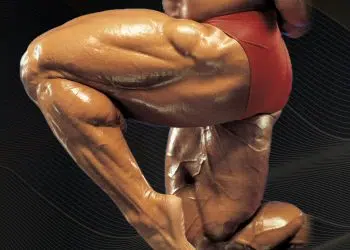Discover the best lying leg curl alternatives to strengthen your hamstrings. Our guide covers 12 effective exercises for all fitness levels, perfect for enhancing your lower body workout routine.
I’ve been a personal trainer for over seven years, and I can’t believe how many people neglect training their hamstrings.
The hamstrings are the biceps of your legs. Just like you cannot have a strong upper body without powerful biceps, you cannot develop a monstrous lower body without jacked hamstrings.
A 2021 study revealed a strong correlation between hamstring muscle volume and sprint performance among national-level sprinters compared to physically active males. It suggests that increased hamstring muscle volume contributes to improved sprinting capabilities. (1)
The Lying Leg Curl Alternatives
Contrary to what most people think, the lying leg curl is not the only way to strengthen the back of your thighs. The following leg curl alternatives will keep your workouts interesting and prevent your muscles from hitting a plateau:
Seated Leg Curl Machine
This is one of the most obvious lying leg curl alternatives. Many people tend to lift their hips off the pad during the lying leg curl, which removes tension from the hamstrings. On the other hand, the setup of the seated leg curl machine helps you keep your hips on the seat, allowing you to focus on the hammies.
Level Up Your Fitness: Join our 💪 strong community in Fitness Volt Newsletter. Get daily inspiration, expert-backed workouts, nutrition tips, the latest in strength sports, and the support you need to reach your goals. Subscribe for free!
How To:
- Sit on the seated leg curl machine with your hamstrings and glutes on the seat.
- Select an appropriate weight.
- Lock your upper legs in place with the thigh pad.
- Grab the handles on the top of the thigh pad. Your knees will be fully extended in the starting position.
- Engage your hamstrings by slightly flexing the knees. The weight should not touch the stack in the starting position.
- Brace your core and flex your knees until your legs are at 90 degrees.
- Pause at the isometric contraction point for a second.
- Slowly return to the starting position.
Pro Tip: If you can’t control the weights on the eccentrics, you’re probably going too heavy. Drop the weights (and your ego) and pick a weight that allows a 3-second eccentric tempo.
Check out our in-depth seated leg curl guide!
TRX Leg Curl
The TRX leg curl might look super easy, but it is notorious for inducing a hamstring cramp. This is my go-to exercise when the lying leg curl machine is busy during the rush hours. The TRX leg curl is also an excellent exercise for folks who train in their garage gyms and can’t afford a dedicated leg curl machine.
How To:
- Anchor the TRX trainers to a sturdy, elevated surface like a pull-up bar.
- Position the D-handles and the loops at your shin level.
- Lie supine on the floor with your legs extended toward the suspension trainers.
- Thread your right foot through the right loop so your ankle rests on it.
- Repeat on the left side.
- Raise your hips off the floor. Your body should be in a straight line at the starting position.
- Brace your core and bring your feet as close to your glutes as possible by flexing your knees.
- Pause in the fully shortened position.
Pro Tip: I have my beginner personal training clients place a rolled yoga mat under their lower back for additional support.
Glute Ham Raise
The rise of CrossFit brought this exercise into the mainstream. The glute ham raise is incredibly effective in high-volume workouts. Use a slow rep tempo for maximal hamstring and glute activation.
How To:
- Insert your feet into the GHD’s ankle pads.
- Place your knees on the edge of the hip pads and cross your arms in front of your chest.
- Your knees should be flexed at 90 degrees at the starting position.
- Take a deep breath and slowly lower your torso toward the floor by extending your knees.
- Pause when your torso is parallel to the floor, and your body is in a straight line.
- Squeeze your hamstrings and glutes to return to the starting position.
Pro Tip: Control the descent by contracting your hamstring and glutes. Folks training for hypertrophy (8-12 rep range) should opt for weighted and banded GHDs for better target muscle stimulation.
Learn all you need to know about the GHD here!
Sliding Leg Curl
Keeping constant tension on the target muscle group is incredibly important for promoting hypertrophy, and this is one of the most effective lying leg curl alternatives to achieve that. You will need core sliders for this exercise, and I highly recommend performing this exercise on a polished surface for a smoother experience.
How To:
- Lie face-up on a wooden floor with your legs extended and your arms at your sides.
- Your feet should be shoulder-width apart and your palms flat on the floor.
- Position a core slider under each heel.
- Raise your hips off the floor and flex your knees slightly to get into the starting position.
- Pull your heels under your hips by contracting your hamstrings.
- Pause at the top of the ROM.
- Return to the starting position.
- Repeat for recommended reps.
Pro Tip: I have my advanced personal training clients perform this exercise using a resistance band. One end of the band is anchored to a pole, and the other is wrapped around their ankles.
Romanian Deadlift
The RDLs are one of my favorite exercises to bias the hamstring and glutes. I prefer using dumbbells for this exercise as they allow a more natural arm and wrist position. Nonetheless, you must use a weight that doesn’t compromise your ROM.
How To:
- Stand upright with a hip-width stance and a dumbbell in each hand resting against your thighs.
- While maintaining a slight knee flexion, slowly lower the dumbbells to the floor by pushing your hips toward the wall behind you.
- You must feel a deep stretch in your hamstring and glutes on the eccentrics. Keep your back, head, and neutral throughout the exercise.
- The dumbbells should be at your mid-shin level at the bottom of the movement.
- Pause in the fully stretched position for a second.
- Return to the starting position by contracting your hamstrings and glutes.
Pro Tip: Use weightlifting straps to eliminate your grip strength. It allows you to better focus on your hamstring and glutes.
Check out the ultimate RDL guide!
Single Leg Deadlift
Unilateral exercises that involve working on one side of the body can help fix muscle and strength imbalances. The single-leg deadlift also improves your mobility, balance, and core stabilizer strength.
How To:
- Stand erect with a shoulder-wide stance, holding a dumbbell in each hand.
- Slightly flex your left knee, raise your leg off the floor, and hold it behind your body.
- Lower the dumbbells toward the floor by hinging at the hips and lowering your torso toward the floor.
- Focus on stretching the hamstrings and glutes throughout the movement.
- The dumbbells should touch the floor at the bottom.
- Return to the starting position.
- Repeat for the desired reps before switching sides.
Pro Tip: Most people confuse the Romanian and stiff-legged deadlifts. At a high level, the RDLs involve lowering the weight to the shin level, whereas you must touch the weight to the floor in the stiff-leg variation.
Dive into this detailed single-leg deadlift guide!
Kettlebell Swing
The kettlebell swing is one of the most underrated lying leg curl alternatives for working the hamstrings and glutes. In my experience, most people rely on their shoulder power during the concentric phase, which is a mistake. You must use your hips and hamstrings to raise the kettlebell to shoulder level.
Level Up Your Fitness: Join our 💪 strong community in Fitness Volt Newsletter. Get daily inspiration, expert-backed workouts, nutrition tips, the latest in strength sports, and the support you need to reach your goals. Subscribe for free!
How To:
- Stand straight with a slightly wider than shoulder-width stance while holding a kettlebell with both hands between your legs.
- Initiate the movement by flexing your knees, hinging at the hips, and threading the kettlebell behind your body from between your legs.
- Focus on contracting your hamstrings on the eccentrics.
- Extend your knees and hips and drive your hips forward explosively into your arms. Use the momentum from your hips to lift the kettlebell to your shoulder level.
- Repeat for the recommended reps.
Pro Tip: A useful tip to ensure correct movement execution is to observe if your arms rise one-third of the way up during the concentric phase, leveraging the momentum from your hips. If you have to use your shoulders to lift the kettlebell, you should pick a lighter weight and focus on drilling the movement.
All you need to know about kettlebell swings!
Nordic Hamstring Curl
Nordic curls are undoubtedly one of the most challenging bodyweight hamstring exercises, as they demand immense control and power.
A systematic review and meta-analysis found that the Nordic hamstring exercise improves sprint performance and eccentric knee flexor strength among team sport players. (2)
You can perform this exercise on a dedicated Nordic curl bench, using a Nordic strap anchored to a door, flat bench, or squat rack, placing your ankles under a loaded barbell, or by having your training partner hold down your ankles.
How To:
- Take your position on a Nordic curl bench with your ankles under the foot pads.
- You should be kneeling with your knees bent at 90 degrees at the starting position.
- Cross your arms in front of your chest.
- Flex your hips slightly.
- Slowly lower your torso toward the floor by leaning forward. Contract your hamstrings to control the descent.
- Break the fall with your hands when your chest is a few inches from the floor.
- Squeeze your glutes and hamstrings to return to the starting position.
- Reverse the movement before your torso is perpendicular to the floor to keep constant tension on the target muscles.
Pro Tip: Beginners can use their arms for an initial boost to lift themselves off the ground and into the starting position. More advanced lifters should solely rely on their hamstring and glute strength for this.
Become a master at Nordic curls with this article!
Ball Leg Curl
The ball leg curl is a hybrid of the TRX and sliding leg curl. I use this exercise with my beginner clients since it involves a relatively limited range of motion, which allows better control and helps them focus on contracting the target muscle group.
How To:
- Lie supine on the floor with your legs extended straight and your arms placed at your sides.
- Position a stability ball under your ankles and shins.
- Lift your hips off the floor so your body is in a straight line.
- Contract your hamstrings and flex your knees until your feet are flat on the ball.
- Squeeze the target muscle in the fully shortened position.
Pro Tip: People who have trouble performing this exercise can use a smaller exercise ball until they master the movement mechanics.
Banded Leg Curl
The banded leg curl is one of the best excellent lying leg curl alternatives for individuals who train in their bare-bone home gym. Start with the lightest resistance band if you’ve never tried this exercise.
How To:
- Wrap one end of a resistance band around a sturdy object like a squat rack.
- Lie prone on the floor with your legs extended toward the squat rack.
- Wrap the other end of the band around your ankles.
- Slightly flex your knees so the band is taut. This will be your starting position.
- While keeping your thighs and hips glued to the floor, flex your knees. Bring your feet as close to your hips as possible.
- Pause and contract your hamstring at the top.
Pro Tip: You could also perform this exercise while seated on an elevated platform like a flat bench. This variation mimics the seated leg curl machine.
Good Mornings
This exercise is better suited for intermediate and advanced lifters. You could think of it as a Romanian deadlift but with the barbell resting across your shoulders.
How To:
- Stand upright with a shoulder-wide stance with a barbell resting across your shoulders in a high bar position.
- While maintaining a slight knee flexion, push your hips backward and hinge your torso toward the floor until you feel a deep hamstring stretch.
- Pause at the bottom for a second.
- Flex your hamstrings and glutes to return to the starting position.
Pro Tip: Using a super squat machine for this exercise can lead to better mind-muscle connection, as it eliminates the need to balance and stabilize the barbell.
Read about Good mornings in detail here!
Cable Pull-Through
Using a cable keeps constant tension on the target muscles, which increases the time under tension and promotes hypertrophy.
How To:
- Connect a rope attachment to a cable pulley adjusted at the lowest setting.
- Stand with your back toward the pulley and the cable between your legs.
- Bend down and grab the ends of the rope attachment using a neutral grip (palms facing each other).
- Take a couple of steps forward to engage the weights.
- Assume a wider-than-hip-width stance, brace your core, and lower the weight toward the pulley by pushing your hips back, lowering your torso toward the floor, and threading your arms through your legs.
- Pause at the bottom and feel a stretch in your hamstrings and glutes.
- Explode back to the starting position.
- Pause and squeeze the target muscles at the top of the ROM.
Pro Tip: Some of my clients have trouble holding onto the rope attachment during this exercise, in which case, I recommend using two D-handle attachments hooked to a single pulley.
Check out our detailed cable pull-through guide here!
Wrapping Up
Bigger upper legs are a combination of jacked quads and hamstrings. Perform two to three of the lying leg curl alternatives detailed in this article to build the coveted piano string hamstrings.
Alternatively, if you have lagging hamstrings, you can string together five to six exercises from the list in a dedicated hamstring workout to fix the gaps in your physique.
If you have any questions about the lying leg curl alternatives, drop them in the comments below, and I’ll be happy to help.
References
- Nuell, S., Illera-Domínguez, V., Carmona, G., Macadam, P., Lloret, M., Padullés, J. M., Alomar, X., & Cadefau, J. A. (2021). Hamstring Muscle Volume as an Indicator of Sprint Performance. Journal of strength and conditioning research, 35(4), 902–909. https://doi.org/10.1519/JSC.0000000000003976
- Bautista, I. J., Vicente-Mampel, J., Baraja-Vegas, L., Segarra, V., Martín, F., & Van Hooren, B. (2021). The effects of the Nordic hamstring exercise on sprint performance and eccentric knee flexor strength: A systematic review and meta-analysis of intervention studies among team sport players. Journal of science and medicine in sport, 24(9), 931–938. https://doi.org/10.1016/j.jsams.2021.03.009
Interested in measuring your progress? Check out our strength standards for Good Morning, Lying Leg Curl, Seated Leg Curl, and more.








